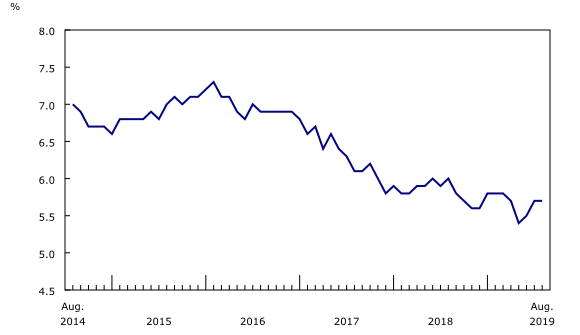Labour Force Survey, August 2019
Archived Content
Information identified as archived is provided for reference, research or recordkeeping purposes. It is not subject to the Government of Canada Web Standards and has not been altered or updated since it was archived. Please "contact us" to request a format other than those available.
Released: 2019-09-06
Following three consecutive months of little change, employment increased by 81,000 in August, largely in part-time work. The unemployment rate remained at 5.7% as more people participated in the labour market.
Compared with August 2018, employment increased by 471,000 (+2.5%), the result of gains in both full- (+306,000 or +2.0%) and part-time work (+165,000 or +4.8%). Over the same period, hours worked were up 1.2%.
To explore the most recent results from the Labour Force Survey in an interactive format, visit the "Labour Force Survey in brief: Interactive app."
Highlights
The bulk of the employment increase in August was in Ontario and Quebec. There were also smaller gains in Manitoba, Saskatchewan and New Brunswick. Employment held steady in the other provinces.
The number of private sector employees increased in August, more than offsetting the decline in July.
There were more people employed in finance, insurance, real estate, rental and leasing; educational services; and in professional, scientific and technical services. In contrast, employment declined in business, building and other support services.
There were more youths aged 15 to 24 and people aged 55 and over working in August.
Employment up in five provinces, led by Ontario
Following two months of little change, employment in Ontario increased by 58,000 in August, all in part-time work. Employment gains were led by wholesale and retail trade. The unemployment rate in the province was little changed at 5.6%. Compared with August 2018, employment in Ontario grew by 250,000 (+3.5%), partly due to employment being at a relatively low point in August 2018. The year-over-year employment gains were in both full- and part-time work.
Employment in Quebec rose for the second consecutive month, up 20,000 in August. There were gains in a number of industries, led by finance, insurance, real estate, rental and leasing. The unemployment rate was little changed at 4.7%, the lowest rate in the province since comparable data became available in 1976, and the lowest among all provinces in August. Compared with 12 months earlier, employment in Quebec increased by 112,000 (+2.6%).
In Manitoba, the number of people employed rose by 5,200, the first notable increase since the start of 2019. The unemployment rate was little changed at 5.6% as more Manitobans participated in the labour market. The employment increase in August brought year-over-year gains to 5,600 (+0.9%).
Employment in Saskatchewan increased by 2,800 in August, lowering the unemployment rate to 5.1% (-0.3 percentage points). Compared with August 2018, employment in the province rose by 13,000 (+2.2%), with gains distributed in a number of industries in the service-producing sector.
In New Brunswick, there were 2,300 more people working in August, partly offsetting the decline in July. The unemployment rate was little changed at 8.6%. Employment in the province was also little changed compared with 12 months earlier.
While employment was little changed in all other provinces in August, the unemployment rate increased in both British Columbia and Nova Scotia. The unemployment rate rose 0.6 percentage points to 5.0% in British Columbia and 0.5 percentage points to 7.9% in Nova Scotia as more people searched for work in each province.
Did you know that the Labour Force Survey has been running for nearly 75 years? Learn more about this important survey in a new video entitled "What is the Labour Force Survey?," released today.
Employment up in three industries
In finance, insurance, real estate, rental and leasing, employment increased by 22,000 in August, bringing year-over-year gains to 46,000 (+3.9%). The increase in August was in Ontario and Quebec.
There were 21,000 more people working in educational services in August, largely in Quebec. Compared with August 2018, employment in this industry at the national level increased by 35,000 (+2.6%).
Following two months of little change, employment increased by 17,000 in professional, scientific and technical services in August, with British Columbia accounting for a large part of the increase. Year-over-year gains in this industry totalled 109,000 or 7.4%, the fastest rate of growth among all major industrial sectors.
Business, building and other support services was the lone industry with fewer people employed in August, down 22,000, mostly the result of declines in Ontario and British Columbia. Compared with August 2018, employment in this industry decreased by 27,000 (-3.5%) as gains in the latter part of 2018 were offset by declines observed so far in 2019.
Employment continues to increase in the services sector
From December 2018 to August 2019, employment growth was entirely in the service-producing sector (+304,000 or +2.0%), reflecting gains in professional, scientific and technical services; wholesale and retail trade; as well as public administration. Service employment gains were concentrated in Ontario (+169,000), Quebec (+58,000) and British Columbia (+52,000).
For Canada as a whole, this growth in service-producing employment coincided with output gains among many service-producing industries. The real gross domestic product of services industries expanded in five of the first six months of the year. In June, the output of service industries was 1.3% higher than at the end of 2018.
Number of private sector employees up in August and year over year
Following a decline in July, the number of private-sector employees increased by 94,000 in August, mostly in finance, insurance, real estate, rental and leasing; wholesale and retail trade; and in transportation and warehousing. At the same time, the number of public-sector employees and self-employed workers held steady.
Compared with 12 months earlier, the number of private-sector employees increased by 394,000 (+3.3%). Over the same period, public-sector employment and the number of self-employed were little changed.
More youth working in August
Employment among youth aged 15 to 24 increased by 42,000 in August, nearly all among young women. The unemployment rate for people in this age group was little changed as more youths participated in the labour market. Compared with August 2018, youth employment rose by 75,000 (+3.0%).
There were more people aged 55 and over working, up 22,000 in August and up 195,000 (+4.9%) from 12 months earlier. Their unemployment rate remained at 4.9% in August as more people in this age group participated in the labour market.
Employment among men and women in the core working ages of 25 to 54 was little changed in August and their unemployment rate held steady at 4.7%. Compared with 12 months earlier, employment in this age group increased by 138,000 (+2.2%) for men and by 64,000 (+1.1%) for women.
Summer employment for students
From May to August, the Labour Force Survey collects labour market data on youth aged 15 to 24 who were attending school full time in March and who intend to return to school full time in the fall. Published data are not seasonally adjusted; therefore, comparisons can only be made on a year-over-year basis.
For returning students aged 15 to 24, average employment for the summer (that is, from May to August) rose by 59,000 (+5.0%) compared with the summer of 2018. Their unemployment rate was 13.1%, little changed compared with the summer of 2018 as more students participated in the labour market. Over the same period, their average employment rate rose 1.6 percentage points to 52.0%.
The increase in employment for returning students was mostly driven by those aged 17 to 19, for whom average employment increased by 44,000 (+9.4%) compared with the summer of 2018. Their employment rate increased 2.6 percentage points to 57.6%, while their unemployment rate was little changed at 13.1%.
In the summer of 2019, average employment for returning students aged 15 and 16, as well as for those aged 20 to 24, was little changed compared with one year earlier. The unemployment rates were also little changed for returning students aged 15 and 16 (23.1%) and for those aged 20 to 24 (8.5%). The employment rate for those aged 15 and 16 was 28.4%, little changed from the previous summer, while the employment rate of students aged 20 to 24 increased 3.4 percentage points to 67.8%.
Sustainable Development Goals
On January 1, 2016, the world officially began implementation of the 2030 Agenda for Sustainable Development—the United Nations' transformative plan of action that addresses urgent global challenges over the next 15 years. The plan is based on 17 specific sustainable development goals.
The Labour Force Survey is an example of how Statistics Canada supports the reporting on the Global Goals for Sustainable Development. This release will be used in helping to measure the following goals:


Note to readers
The Labour Force Survey (LFS) estimates for August are for the week of August 11 to 17.
The LFS estimates are based on a sample and are therefore subject to sampling variability. As a result, monthly estimates will show more variability than trends observed over longer time periods. For more information, see "Interpreting Monthly Changes in Employment from the Labour Force Survey."
Estimates for smaller geographic areas or industries also have more variability. For an explanation of the sampling variability of estimates and how to use standard errors to assess this variability, consult the "Data quality" section of the publication Labour Force Information (71-001-X).
This analysis focuses on differences between estimates that are statistically significant at the 68% confidence level.
The LFS estimates are the first in a series of labour market indicators released by Statistics Canada, which includes indicators from programs such as the Survey of Employment, Payrolls and Hours (SEPH), Employment Insurance Statistics, and the Job Vacancy and Wage Survey. For more information on the conceptual differences between employment measures from the LFS and SEPH, refer to section 8 of the Guide to the Labour Force Survey (71-543-G).
The employment rate is the number of employed people as a percentage of the population aged 15 and older. The rate for a particular group (for example, youths aged 15 to 24) is the number employed in that group as a percentage of the population for that group.
The unemployment rate is the number of unemployed people as a percentage of the labour force (employed and unemployed).
The participation rate is the number of employed and unemployed people as a percentage of the population.
Full-time employment consists of persons who usually work 30 hours or more per week at their main or only job.
Part-time employment consists of persons who usually work less than 30 hours per week at their main or only job.
Total hours worked refers to the number of hours actually worked at the main job by the respondent during the reference week, including paid and unpaid hours. These hours reflect temporary decreases or increases in work hours (for example, hours lost due to illness, vacation, holidays, or weather; or more hours worked due to overtime).
In general, month-to-month or year-to-year changes in the number of people employed in an age group reflect the net effect of two factors: (1) the number of people who changed employment status between reference periods; and (2) the number of employed people who entered or left the age group (including through aging, death or migration) between reference periods.
Seasonal adjustment
Unless otherwise stated, this release presents seasonally adjusted estimates, which facilitate comparisons by removing the effects of seasonal variations. For more information on seasonal adjustment, see Seasonally adjusted data – Frequently asked questions.
Chart 1 shows trend-cycle data on employment. These data represent a smoothed version of the seasonally adjusted time series, which provides information on longer-term movements, including changes in direction underlying the series. These data are available for the national and provincial employment series in table 14-10-0287-01 and for national employment by industry in table 14-10-0355-01. For more information, see the StatCan Blog and Trend-cycle estimates – Frequently asked questions.
Next release
The next release of the LFS will be on October 11.
Products
Labour Force Information (71-001-X), is now available for the week ending August 17.
More information about the concepts and use of the Labour Force Survey is available online in the Guide to the Labour Force Survey (71-543-G).
The product "Labour Force Survey in brief: Interactive app" (14200001) is now available. This interactive visualization application provides seasonally adjusted estimates available by province, sex, age group and industry. Historical estimates going back five years are also included for monthly employment changes and unemployment rates. The interactive application allows users to quickly and easily explore and personalize the information presented. Combine multiple provinces, sexes and age groups to create your own labour market domains of interest.
The product "Labour Market Indicators, by census metropolitan area, seasonally adjusted" (71-607-X) is also available. This interactive dashboard provides easy, customizable access to key labour market indicators. Users can now configure an interactive map and chart showing labour force characteristics at the national, provincial or census metropolitan area level.
The product "Labour Market Indicators, by province, territory and economic region, unadjusted for seasonality" (71-607-X) is also available. This dynamic web application provides access to Statistics Canada's labour market indicators for Canada, by province, territory and economic region and allows users to view a snapshot of key labour market indicators, observe geographical rankings for each indicator using an interactive map and table, and easily copy data into other programs.
Contact information
For more information, contact us (toll-free: 1-800-263-1136; 514-283-8300; STATCAN.infostats-infostats.STATCAN@canada.ca).
To enquire about the concepts, methods or data quality of this release, contact Vincent Ferrao (613-951-4750; vincent.ferrao@canada.ca) or Emmanuelle Bourbeau (613-951-3007; emmanuelle.bourbeau@canada.ca), Centre for Labour Market Information.
- Date modified:





